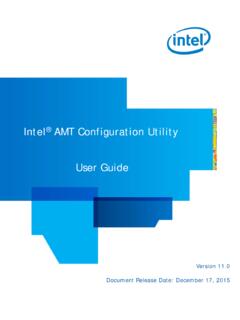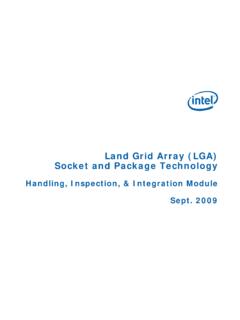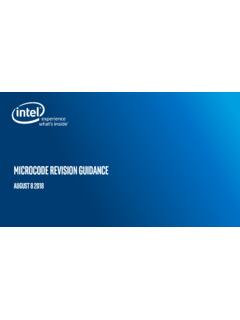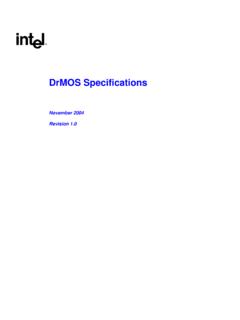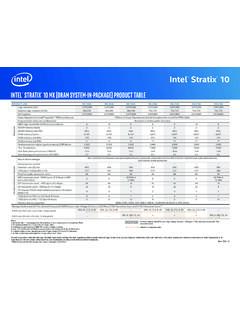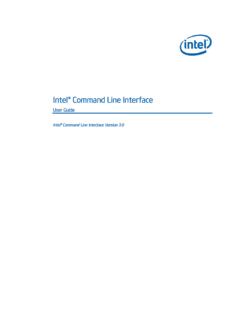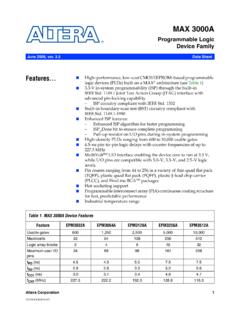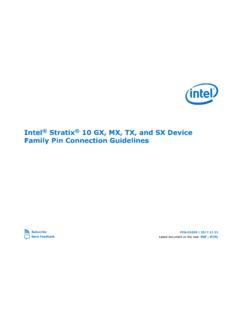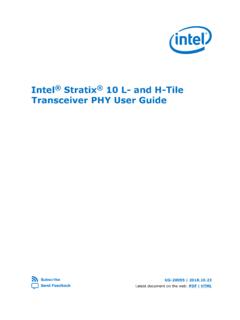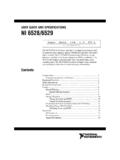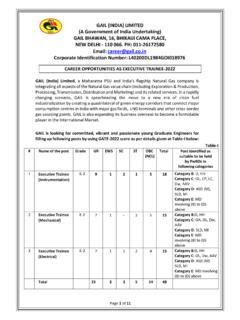Transcription of for Server Configuration on Intel® Server Boards and Intel ...
1 Basic Instructions for Using the Extensible Firmware Interface (EFI). for Server Configuration on Intel Server Boards and Intel Server Systems Revision June 2008. Enterprise Platforms and Services Division Revision History Basic Instructions for Using the Extensible Firmware Interface (EFI). Revision History Date Revision Modifications Number January 2008 Initial release. June 2008 Content revised. Disclaimers Information in this document is provided in connection with Intel products. No license, express or implied, by estoppel or otherwise, to any intellectual property rights is granted by this document. Except as provided in Intel 's Terms and Conditions of Sale for such products, Intel assumes no liability whatsoever, and Intel disclaims any express or implied warranty, relating to sale and/or use of Intel products including liability or warranties relating to fitness for a particular purpose, merchantability, or infringement of any patent, copyright or other intellectual property right.
2 Intel products are not intended for use in medical, life saving, or life sustaining applications. Intel may make changes to specifications and product descriptions at any time, without notice. Designers must not rely on the absence or characteristics of any features or instructions marked "reserved" or "undefined." Intel reserves these for future definition and shall have no responsibility whatsoever for conflicts or incompatibilities arising from future changes to them. This document may contain design defects or errors known as errata which may cause the product to deviate from published specifications. Current characterized errata are available on request. Intel , Pentium, Celeron, and Xeon are trademarks or registered trademarks of Intel Corporation or its subsidiaries in the United States and other countries. Copyright Intel Corporation 2008.
3 *Other names and brands may be claimed as the property of others. ii Revision Basic Instructions for Using the Extensible Firmware Interface (EFI) Table of Contents Table of Contents 1. Using 1. Preparing removable media and making its format readable under 1. Booting to the EFI Shell .. 1. Basic EFI Commands .. 2. Running the EFI script under the EFI Shell .. 3. EFI script examples .. 3. Example of under System Firmware Update Package .. 4. Example of under System Firmware Update 5. EFI environmental 6. Appendix A: EFI 7. Revision iii Table of Contents Basic Instructions for Using the Extensible Firmware Interface (EFI). < This page intentionally left blank. >. iv Revision Basic Instructions for Using the Extensible Firmware Interface (EFI) Using EFI. 1. Using EFI. Preparing removable media and making its format readable under EFI. You must format the media (USB key, CD, and hard drives) as FAT (16 or 32) in order for them to be readable from EFI.
4 For a USB disk on key or hard drives, you can use Disk Management (available under the Computer Management option of Windows), DOS format, or any other third party software to format it to FAT or FAT32 format. For a writable CD, you must create the CD in FAT format. If you use a popular CD burn software, you must first copy the files that need to go on the CD to a FAT or FAT32 file system partition, and then use the CD burn software to burn the contents to CD-ROM (boot) . You may also choose any commercial CD burn software. You must make sure that the burned CD is FAT or FAT32 based so that EFI can read the CD contents. The instructions for creating the CD in FAT format are readily available on the Internet and in the documentation that comes with the commercial CD burn software (simply search on build CD or build ISO ). Note: If you want to use a CD to perform a System Firmware Update from EFI, you must copy/burn the System Firmware Update package contents to a writable CD.
5 Booting to the EFI Shell All Intel Server Boards using the 5000, 5400, 7000, 3000 and 3200 series chipsets support booting to an EFI shell without any additional operating system present. To temporarily boot to the EFI shell: 1. Press F2 when prompted during POST to enter the BIOS utility. 2. Within the BIOS utility, arrow over to the Boot Manager and press <Enter>. 3. Arrow down and highlight the EFI Shell option. 4. Press <Enter> to go directly to the EFI Shell. By default, the EFI shell is the last item in the Boot Order list. It can be set as the first item in the Boot Order list so that the system always boots into EFI. To do this: 1. Press F2 when prompted during POST to enter the BIOS utility. 2. Within the BIOS utility, arrow over to Boot Options and press <Enter>. 3. Highlight the first option and press <Enter>. Revision 1. Using EFI Basic Instructions for Using the Extensible Firmware Interface (EFI).
6 4. Arrow down to the EFI Shell option and press <Enter>. 5. Press F10 to save this Configuration and reset. Upon booting to the EFI shell, the embedded OS always looks for a file named (by searching through the defined path ). is the equivalent of in the DOS/Windows environment. After running this startup script (if found), the following command line prompt appears: Shell>. Basic EFI Commands EFI commands are very similar to common DOS and Linux commands. The most frequently used commands include: ls (or dir): Lists the directory contents. cd: Changes the directory. cp: Copies one or more files/directories to another location. move: Moves one or more files/directories to the destination. rm: Deletes one or more files or directories. map: Displays, resets, or deletes mappings with the verbose option. map r: Commonly used to refresh mapped drives.
7 Edit: Starts a basic text editor with on-screen function key help. set: Displays (set), creates (set sname value), deletes (set d), or changes EFI. environment variables. cls: Clears the screen and can also change the background color. echo: Displays results on the screen. help: Displays help information. exit: Leaves the EFI shell and returns to the BIOS utility. reset: Resets the system with a warm reboot or complete shutdown. Note: For most commands, EFI is not case sensitive. However, EFI can be case sensitive for file paths and names depending on the media. For a full list of commands, see Appendix A. 2 Revision Basic Instructions for Using the Extensible Firmware Interface (EFI) Using EFI. Running the EFI script under the EFI Shell Change from the EFI shell to the USB device folder: The first USB device found shows up in the mapping as fs0 (File system 0); the next device shows up as fs1, etc.
8 If you add a new media after the initial mapping or if you change it at any time while in the EFI shell, type the command: map r (This command refreshes the mounting and mapping). To change from the shell to the media, type the fs# followed by a colon (:). The prompt displays the current directory. shell> fs0: becomes fs0:>. Note: Once you have changed to media, you may change to other media including RAM disks (commonly fsz:) but there is no need to return to the base shell. Run the EFI script which is under the USB device. An EFI script ends with .nsh. You can edit the .nsh script to add a bunch of commands to perform certain tasks. As is the equivalent of in the DOS/Windows environment, Intel usually provides the script in the System Firmware Update package. This script is used to perform all System Firmware Update tasks. To manually run the script, type: fs0:> or fs0:> startup To run your own script, type: fs0:> or fs0:> bios EFI script examples EFI script is not just the combination of some EFI commands; it may contain some batch only commands as well: Revision 3.
9 Using EFI Basic Instructions for Using the Extensible Firmware Interface (EFI).. endif .. endfor Example of under System Firmware Update Package @echo -off mode 80 25. ;foundimage section is simply to locate the correct drive cls if exist .\ then goto FOUNDIMAGE. endif if exist fs0:\ then fs0: echo Found Update Packages on fs0: goto FOUNDIMAGE. endif if exist fs1:\ then fs1: echo Found Update Packages on fs1: goto FOUNDIMAGE. endif if exist fs2:\ then fs2: echo Found Update Packages on fs2: goto FOUNDIMAGE. endif echo "Unable to find Update Packages". echo "Please mount the drive with the update package". echo "". goto END. :FOUNDIMAGE. echo ======================================== =====================. echo "This utility will allow you to update the BIOS and firmware.". echo "If you want to do all these functions, press Enter. If not, hit 'q'.".
10 Echo "if you want to update single components like BMC/BIOS. separately,". echo "please go to the EFIscripts folder and execute the specified scripts". echo "separately.". echo "Do NOT reboot during this process until you see Updates completed.". 4 Revision Basic Instructions for Using the Extensible Firmware Interface (EFI) Using EFI. echo "Pre release updates may take significant time with a 20. minute HSC update.". echo ======================================== =====================. pause echo "". echo "". echo Update S5400SF BMC flash using FWPIAUPD utility echo "". fwpiaupd -u -o -b -pia -nopc -ni -p echo "". echo " ". echo Updating the FRU and Sensor Data Records frusdr -cfg echo " ". echo "". echo Updating SR1500 BP HSC FW to version echo "". fwpiaupd -u -b echo "". echo Updating BIOS /u /ni echo ..Done echo **. **. echo "Updates completed.
